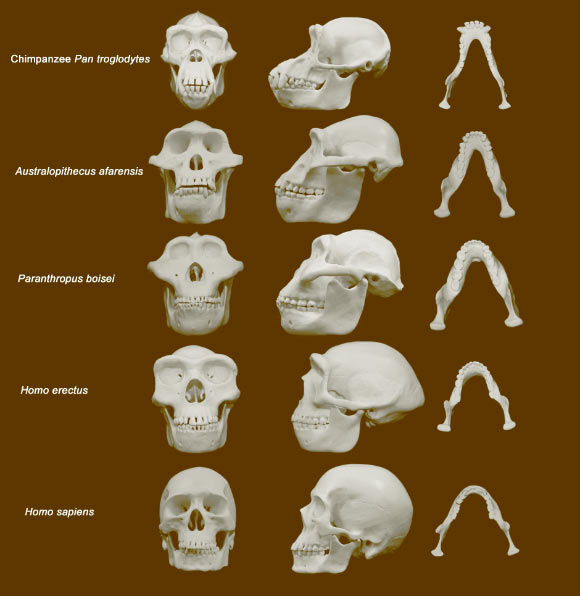Hominin faces – especially those of australopithecines – evolved to minimize injury from punches to the face during fights between males – over resources, women and other disagreements, according to a review study conducted by Dr David Carrier and Dr Michael Morgan from the University of Utah.

Top to bottom: skull reconstructions of the common chimpanzee Pan troglodytes, Australopithecus afarensis, Paranthropus boisei, Homo erectus and Homo sapiens. Scale bar – 10 cm. Image credit: University of Utah.
The study, reported in the journal Biological Reviews, presents an alternative to the long-held hypothesis that the evolution of the robust faces of our early ancestors resulted largely from the need to chew hard-to-crush foods such as nuts.
“The study provides an alternative explanation for the evolution of the hominin face, but also addresses the debate over whether or not our distant past was violent,” Dr Carrier explained.
“The debate over whether or not there is a dark side to human nature goes back to the French philosopher Jean-Jacques Rousseau who argued that before civilization humans were noble savages; that civilization actually corrupted humans and made us more violent. This idea remains strong in the social sciences and in recent decades has been supported by a handful of outspoken evolutionary biologists and anthropologists. Many other evolutionary biologists, however, find evidence that our distant past was not peaceful.”
The results of the study show that violence played a greater role in human evolution than previously thought.
When modern humans fight hand-to-hand the face is usually the primary target. Dr Carrier and Dr Morgan found that the bones that suffer the highest rates of fracture in fights are the same parts of the skull that exhibited the greatest increase in robusticity during the evolution of fossil hominins.
These bones are also the parts of the skull that show the greatest difference between males and females in both australopithecines (Australopithecus and Paranthropus spp.) and humans.
In other words, male and female faces are different because the parts of the skull that break in fights are bigger in males.
“Importantly, these facial features appear in the fossil record at approximately the same time that our ancestors evolved hand proportions that allow the formation of a fist,” Dr Carrier said.
“Together these observations suggest that many of the facial features that characterize early hominins may have evolved to protect the face from injury during fighting with fists.”
“The australopithecines were characterized by a suite of traits that may have improved fighting ability, including hand proportions that allow formation of a fist; effectively turning the delicate musculoskeletal system of the hand into a club effective for striking,” Dr Carrier explained.
“If indeed the evolution of our hand proportions were associated with selection for fighting behavior you might expect the primary target, the face, to have undergone evolution to better protect it from injury when punched.”
“Our research is about peace. We seek to explore, understand, and confront humankind’s violent and aggressive tendencies. Peace begins with ourselves and is ultimately achieved through disciplined self-analysis and an understanding of where we’ve come from as a species. Through our research we hope to look ourselves in the mirror and begin the difficult work of changing ourselves for the better,” Dr Morgan added.
______
David R. Carrier & Michael H. Morgan. Protective buttressing of the hominin face. Biological Reviews, published online June 09, 2014; doi: 10.1111/brv.12112







